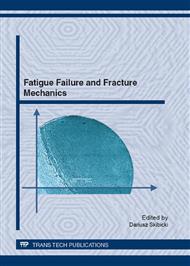[1]
R. S. Mishra, Friction Stir Processing technologies, Advanced Mater. Processes, October 2003.
Google Scholar
[2]
H. Fuji, L. Cui, M. Maeda, K. Nogi, Effect of tool shape on mechanical properties and microstructure of friction stir welded aluminium alloys, Mater. Sci. Eng. A 419, 2006, pp.25-31.
DOI: 10.1016/j.msea.2005.11.045
Google Scholar
[3]
H. J. Schmidt, B. Schmidt-Brandecker, Advanced materials and manufacturing technologies for aircraft application. 2nd Int. Conf. Material and component performance under variable amplitude loading. 2009, Germany, pp.67-87.
Google Scholar
[4]
L.J.J. Kok, K. Poston, G. Moore, Bombardier aerospace FSW demonstrator. ICAF 2011 Structural Integrity: Influence of Efficiency and Green Imperatives. Springer, New York, 2011, Proc. 26th ICAF Symposium, Canada, 2011, pp.73-81.
DOI: 10.1007/978-94-007-1664-3_5
Google Scholar
[5]
L.Cui, H. Fuji, N. Tsuji, K. Nogi, Friction stir welding of a high carbon steel, Scripta Mater., Vol. 56, 2007, pp.637-640.
DOI: 10.1016/j.scriptamat.2006.12.004
Google Scholar
[6]
Cho Hoon-Hwe, Heung Nam Han, Sung-Tae Hong et al. Microstructural analysis of friction stir welded ferritic stainless steel. Mater. Sci. Eng. A 528 (211) pp.2889-2894
DOI: 10.1016/j.msea.2010.12.061
Google Scholar
[7]
A.P. Reynolds, Wei Tang, T. Gnaupel-Herpld, H. Prask, Structure, properties and residual stress of 304L stainless steel friction stir welds, Scripta Mater. 48 (2003), pp.1289-1294
DOI: 10.1016/s1359-6462(03)00024-1
Google Scholar
[8]
J. Gandra, R. Miranda, P. Vilica, J.P. Teixeira, Functionally graded materials produced by friction stir processing. J. Mater. Proc. Tech. 211 (2011), pp.1659-1668.
DOI: 10.1016/j.jmatprotec.2011.04.016
Google Scholar
[9]
D. Kocańda, A. Górka, Formation of a metal coating by means of friction stir processing, ICAF 2011 Structural Integrity: Influence of Efficiency and Green Imperatives. Springer, New York, 2011, Proc. 26th ICAF Symposium, Canada, 2011, pp.167-178.
DOI: 10.1007/978-94-007-1664-3_13
Google Scholar
[10]
A. Neimitz, Fracture mechanics, PWN SA, Warsaw, 1998 (in Polish).
Google Scholar


